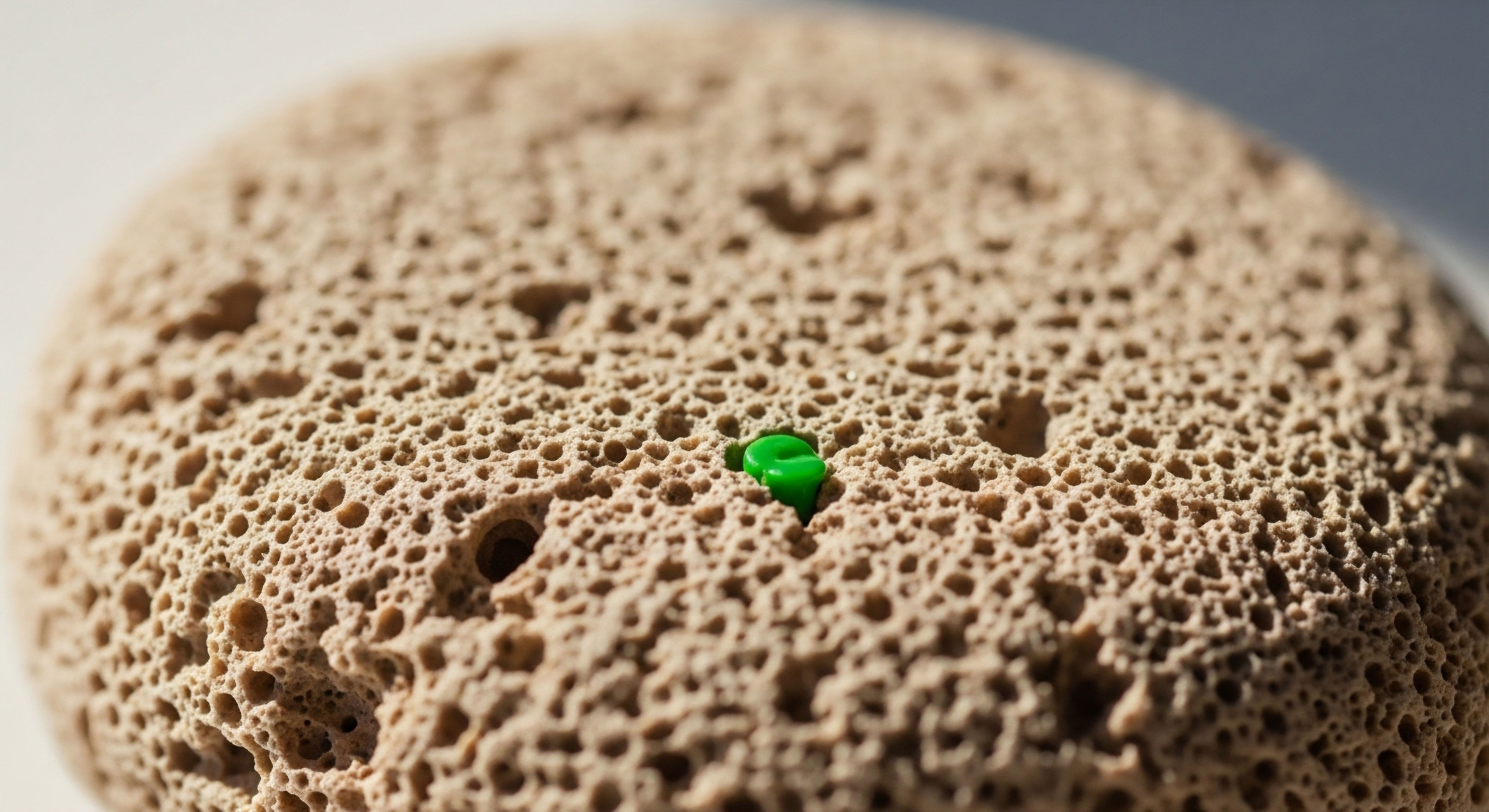

Fundamentals
Experiencing a sudden shift in your body’s equilibrium can be disorienting, particularly when you have taken a proactive step towards wellness by initiating hormonal support. Perhaps you began therapy feeling a renewed sense of optimism, only to encounter an unexpected laboratory result ∞ a significantly reduced level of Sex Hormone Binding Globulin, or SHBG.
This outcome might leave you questioning the very mechanisms at play within your physiology, wondering if this change aligns with your therapeutic goals. Your personal journey toward vitality is precisely that ∞ personal ∞ and understanding these biochemical signals is a crucial step in recalibrating your internal systems.
Many individuals report a feeling of confusion when their SHBG levels decline after starting hormonal optimization protocols. This response is a common physiological adjustment, not necessarily an adverse event. Your body is a complex network of chemical messengers, and SHBG plays a specific, regulatory role within this intricate system. Recognizing the body’s adaptive responses to therapy helps in interpreting these changes as part of a broader, interconnected process.
A significant reduction in SHBG levels after initiating hormonal therapy is a common physiological adjustment, not necessarily an adverse event.

Understanding Sex Hormone Binding Globulin
Sex Hormone Binding Globulin is a glycoprotein produced primarily by the liver. Its main function involves binding to sex hormones, specifically testosterone, dihydrotestosterone (DHT), and estradiol, transporting them throughout the bloodstream. Think of SHBG as a transport vehicle or a reservoir for these potent chemical messengers.
When hormones are bound to SHBG, they are generally considered biologically inactive, meaning they cannot directly interact with target cells and exert their effects. Only the “free” or unbound portion of these hormones is readily available to tissues.
The balance between bound and unbound hormones is dynamic, constantly adjusting based on physiological needs and external influences. A high SHBG level means more sex hormones are bound, potentially reducing the amount of free, active hormone available to your cells. Conversely, a lower SHBG level implies more free hormone is circulating, ready to engage with receptors and elicit biological responses. This intricate dance of binding and releasing ensures that tissues receive the appropriate hormonal signals at the right time.

The Initial Impact of Hormonal Support
When you begin a hormonal optimization protocol, such as Testosterone Replacement Therapy (TRT), the introduction of exogenous hormones directly influences your body’s existing endocrine environment. Your system perceives an increased availability of these hormones. In response, the liver, which synthesizes SHBG, often reduces its production of this binding protein. This reduction is a natural feedback mechanism, an attempt by the body to maintain a perceived balance in the face of increased hormonal input.
This physiological adaptation aims to prevent an excessive surge of free hormones, which could lead to unintended consequences. The body strives for homeostasis, a state of internal stability, and its regulatory systems are constantly working to achieve this. A reduction in SHBG can therefore be viewed as a sign that your body is actively responding to the therapy, adjusting its internal transport mechanisms to accommodate the new hormonal landscape.

Why SHBG Levels Matter
The concentration of SHBG in your blood provides a window into your overall hormonal and metabolic health. Beyond its role in hormone transport, SHBG levels are influenced by various factors, including insulin sensitivity, thyroid function, and liver health. A significant decline in SHBG after starting therapy, while often expected, warrants careful consideration. It suggests a shift in the availability of biologically active hormones, which can impact how you feel and how your body functions at a cellular level.
Understanding these interconnections helps you and your clinical team interpret your laboratory results with greater precision. It moves beyond simply looking at total hormone levels to assessing the fraction of hormones truly accessible to your tissues. This deeper understanding empowers you to engage more fully in your wellness journey, transforming complex data into actionable insights for your health.


Intermediate
A decline in Sex Hormone Binding Globulin after initiating hormonal support protocols is a frequently observed phenomenon, particularly with Testosterone Replacement Therapy. This change is not arbitrary; it reflects the body’s sophisticated adaptive mechanisms responding to the introduction of exogenous hormones. Understanding the specific clinical protocols and their physiological ramifications provides clarity regarding these shifts. The primary goal of these therapies is to restore optimal hormonal balance, and the SHBG response is an integral part of that recalibration.
The liver’s synthesis of SHBG is highly sensitive to circulating hormone levels, especially androgens and estrogens. When external testosterone is introduced, the liver often downregulates SHBG production. This mechanism ensures that a greater proportion of the administered testosterone remains in its free, biologically active form, ready to exert its effects on target tissues. This is a desired outcome for many individuals seeking to alleviate symptoms associated with low testosterone, such as diminished vitality, reduced muscle mass, or altered mood.
SHBG reduction during testosterone therapy often signifies increased free hormone availability, aligning with therapeutic goals.

Testosterone Replacement Therapy for Men
For men experiencing symptoms of low testosterone, a common protocol involves weekly intramuscular injections of Testosterone Cypionate (200mg/ml). This approach aims to restore physiological testosterone levels, addressing concerns such as fatigue, decreased libido, and muscle weakness. The introduction of this exogenous testosterone directly influences the body’s endocrine feedback loops.
To maintain natural testosterone production and fertility, Gonadorelin is often included, typically administered via subcutaneous injections twice weekly. Gonadorelin stimulates the pituitary gland to release Luteinizing Hormone (LH) and Follicle-Stimulating Hormone (FSH), which in turn signal the testes to produce testosterone and sperm. This co-administration helps mitigate testicular atrophy and preserves endogenous function.
Another component often integrated into male TRT protocols is Anastrozole, an aromatase inhibitor, usually taken as an oral tablet twice weekly. Testosterone can convert into estrogen through the aromatase enzyme. While some estrogen is beneficial for men, excessive conversion can lead to side effects such as gynecomastia or water retention. Anastrozole helps manage estrogen levels, ensuring a more balanced hormonal environment. The reduction in SHBG can sometimes lead to a higher free estrogen fraction, making estrogen management even more pertinent.
In some cases, Enclomiphene may be included to support LH and FSH levels, particularly for men concerned with fertility preservation or those seeking to stimulate their own testosterone production without direct exogenous testosterone administration. This selective estrogen receptor modulator (SERM) works by blocking estrogen’s negative feedback on the pituitary, thereby increasing gonadotropin release.

Testosterone Replacement Therapy for Women
Women also experience symptoms related to hormonal changes, including irregular cycles, mood fluctuations, hot flashes, and reduced libido. For these individuals, Testosterone Replacement Therapy can be a transformative intervention. Protocols for women are carefully calibrated to their unique physiology.
A typical approach involves Testosterone Cypionate, administered weekly via subcutaneous injection, usually in very low doses (e.g. 10 ∞ 20 units or 0.1 ∞ 0.2ml). This precise dosing helps optimize testosterone levels without inducing virilizing side effects. The goal is to restore vitality, cognitive clarity, and sexual health.
Progesterone is often prescribed alongside testosterone, with the specific dosage and timing based on the woman’s menopausal status. For pre-menopausal women, progesterone can help regulate menstrual cycles and support reproductive health. For peri-menopausal and post-menopausal women, it provides crucial support for uterine health and symptom management.
Another option for women is Pellet Therapy, which involves the subcutaneous insertion of long-acting testosterone pellets. This method provides a consistent release of testosterone over several months, offering convenience and stable hormone levels. Anastrozole may be used with pellet therapy when appropriate, particularly if estrogen levels become elevated, to manage potential side effects.
The table below illustrates common medications and their roles in these protocols:
| Medication | Primary Role in Therapy | Relevance to SHBG |
|---|---|---|
| Testosterone Cypionate | Restores testosterone levels | Directly reduces SHBG synthesis |
| Gonadorelin | Stimulates natural hormone production | Supports HPG axis, indirectly influences SHBG |
| Anastrozole | Manages estrogen conversion | Helps balance free estrogen levels, important with lower SHBG |
| Progesterone | Supports female hormonal balance | Can influence SHBG, often increases it slightly |
| Enclomiphene | Stimulates LH/FSH release | Increases endogenous testosterone, leading to SHBG reduction |

Growth Hormone Peptide Therapy
Beyond direct hormone replacement, peptide therapies offer another avenue for optimizing metabolic function and overall well-being. These agents work by stimulating the body’s natural production of growth hormone, rather than introducing it exogenously. Active adults and athletes often seek these therapies for anti-aging benefits, muscle gain, fat loss, and improved sleep quality.
Key peptides in this category include Sermorelin, Ipamorelin / CJC-1295, Tesamorelin, Hexarelin, and MK-677. These compounds act on different pathways to stimulate the pituitary gland’s release of growth hormone. While their direct impact on SHBG is less pronounced than that of testosterone, growth hormone itself can influence hepatic protein synthesis, including SHBG. Improved metabolic health, a common outcome of growth hormone optimization, can indirectly affect SHBG levels by improving insulin sensitivity.
The list below details some common growth hormone-releasing peptides:
- Sermorelin ∞ A growth hormone-releasing hormone (GHRH) analog that stimulates the pituitary.
- Ipamorelin / CJC-1295 ∞ A combination that provides a sustained release of growth hormone.
- Tesamorelin ∞ A GHRH analog specifically approved for reducing abdominal fat.
- Hexarelin ∞ A growth hormone secretagogue that also has cardiovascular benefits.
- MK-677 ∞ An oral growth hormone secretagogue that increases growth hormone and IGF-1 levels.

Other Targeted Peptides
The landscape of personalized wellness protocols extends to other targeted peptides addressing specific concerns. PT-141, for instance, is utilized for sexual health, acting on melanocortin receptors in the brain to enhance libido and sexual function. Its mechanism is distinct from direct hormonal pathways, but it contributes to overall well-being, which is intertwined with hormonal balance.
Another significant peptide is Pentadeca Arginate (PDA), which is gaining recognition for its role in tissue repair, healing, and inflammation modulation. PDA supports cellular regeneration and reduces inflammatory responses, which can indirectly influence metabolic health and, by extension, the factors that regulate SHBG. A body in a state of reduced inflammation and optimal tissue repair is better equipped to maintain hormonal equilibrium.


Academic
The phenomenon of a reduced Sex Hormone Binding Globulin level following the initiation of hormonal therapy warrants a rigorous examination from a systems-biology perspective. This biochemical adjustment is not merely a numerical change on a laboratory report; it represents a complex interplay within the endocrine system, reflecting adaptive responses at the hepatic and cellular levels. Understanding the intricate regulatory mechanisms governing SHBG synthesis and its implications for free hormone availability is central to optimizing patient outcomes.
The liver serves as the primary site for SHBG synthesis, a process influenced by a multitude of factors. Hepatic SHBG production is transcriptionally regulated, meaning the rate at which the gene for SHBG is expressed directly impacts circulating levels. Hormones such as insulin, thyroid hormones, and growth hormone exert significant control over this process.
For instance, states of insulin resistance or hyperinsulinemia are consistently associated with reduced SHBG levels, as insulin directly suppresses hepatic SHBG gene expression. This connection highlights the deep interrelationship between metabolic health and hormone transport.
SHBG synthesis in the liver is intricately regulated by insulin, thyroid hormones, and growth hormone, linking metabolic health to hormone transport.

The Hypothalamic-Pituitary-Gonadal Axis and SHBG
The Hypothalamic-Pituitary-Gonadal (HPG) axis represents the central command and control system for reproductive and hormonal function. The hypothalamus releases Gonadotropin-Releasing Hormone (GnRH), which stimulates the pituitary gland to secrete Luteinizing Hormone (LH) and Follicle-Stimulating Hormone (FSH). These gonadotropins then act on the gonads (testes in men, ovaries in women) to produce sex hormones.
When exogenous testosterone is administered, as in Testosterone Replacement Therapy, it exerts a negative feedback effect on the hypothalamus and pituitary. This suppression reduces the endogenous production of LH and FSH, subsequently decreasing the gonads’ natural testosterone output. While this feedback primarily affects endogenous hormone synthesis, the overall increase in circulating testosterone, particularly the free fraction, directly influences hepatic SHBG production. The liver perceives an abundance of circulating androgens, leading to a downregulation of SHBG synthesis as a homeostatic adjustment.
This feedback loop is critical. A significant reduction in SHBG means a greater proportion of the total testosterone becomes biologically active. This can be highly beneficial for symptom resolution, but it also necessitates careful monitoring of other hormone metabolites, particularly estrogen. With more free testosterone available for aromatization, there is a potential for increased estrogen conversion, which may require management with agents like Anastrozole to prevent undesirable effects.

Metabolic Pathways and SHBG Regulation
The relationship between SHBG and metabolic health extends beyond insulin sensitivity. Chronic inflammation, often measured by markers such as C-reactive protein, has been linked to lower SHBG levels. Inflammatory cytokines can directly influence hepatic gene expression, potentially suppressing SHBG synthesis. This suggests that addressing underlying inflammatory states could play a role in modulating SHBG, even in the context of hormonal therapy.
Thyroid hormones also play a significant role in SHBG regulation. Hyperthyroidism is typically associated with elevated SHBG levels, while hypothyroidism often leads to reduced SHBG. This indicates that a comprehensive assessment of hormonal health must include thyroid function, as it can indirectly influence the availability of sex hormones to target tissues. The liver’s metabolic state, influenced by nutritional status and overall systemic health, directly impacts its capacity to synthesize and regulate SHBG.

What Are the Implications of Very Low SHBG?
While a moderate reduction in SHBG is an expected and often desired outcome of testosterone therapy, extremely low SHBG levels warrant careful clinical consideration. Very low SHBG implies a higher proportion of free testosterone and estradiol. This increased free hormone exposure can lead to several physiological consequences.
One primary concern is the potential for increased conversion of testosterone to estradiol, as more substrate is available for the aromatase enzyme. This can result in elevated free estradiol levels, which may contribute to symptoms such as fluid retention, mood lability, or gynecomastia in men. For women, excessively high free testosterone, even with low total levels, can lead to virilizing effects.
Furthermore, while a higher free hormone fraction is generally beneficial, excessively low SHBG might also influence target tissue sensitivity over time. The precise mechanisms are still under investigation, but some research suggests that SHBG itself may have direct cellular effects beyond its binding role, potentially acting as a signaling molecule. A dramatic crash in SHBG could therefore alter these subtle cellular interactions.
Monitoring free testosterone and estradiol levels becomes even more critical when SHBG is significantly reduced. Clinical adjustments to therapy, such as reducing testosterone dosage or incorporating aromatase inhibitors, may be necessary to maintain optimal free hormone ratios and mitigate potential side effects. The goal is to achieve a physiological balance that supports vitality without compromising long-term health.
The table below outlines factors influencing SHBG levels:
| Factor | Effect on SHBG | Clinical Relevance |
|---|---|---|
| Exogenous Androgens | Decreases | Expected response to TRT |
| Insulin Resistance | Decreases | Metabolic health link, common in obesity |
| Hypothyroidism | Decreases | Requires thyroid function assessment |
| Chronic Inflammation | Decreases | Indicates systemic stress, potential for metabolic dysfunction |
| Growth Hormone | Increases | GH therapy can influence SHBG upwards |
| Estrogens (Endogenous) | Increases | High estrogen can elevate SHBG |

How Does SHBG Impact Overall Well-Being?
The impact of SHBG extends beyond simple hormone transport. Its levels are independently associated with various health markers, serving as a biomarker for metabolic health and disease risk. For instance, lower SHBG levels have been correlated with an increased risk of developing type 2 diabetes, even in individuals with normal glucose tolerance. This association holds true for both men and women, suggesting a fundamental role for SHBG in metabolic regulation.
Additionally, SHBG levels have been implicated in cardiovascular health. Some studies indicate that lower SHBG may be associated with an increased risk of cardiovascular events, possibly due to its link with insulin resistance and systemic inflammation. This connection underscores the importance of considering SHBG not just as a hormone binder, but as a marker reflecting broader physiological states.
From a neurological perspective, optimal hormonal balance, influenced by SHBG, plays a role in cognitive function and mood regulation. While direct evidence linking SHBG levels to specific neurological outcomes is still developing, the availability of free sex hormones is crucial for brain health. Understanding these systemic interconnections allows for a more comprehensive approach to personalized wellness protocols, ensuring that therapeutic interventions consider the entire biological landscape.

References
- Selva, D. M. & Hammond, G. L. (2009). Sex hormone-binding globulin ∞ a synthesis of its regulation and biological functions. Endocrine Reviews, 30(3), 267-323.
- Handelsman, D. J. & Gooren, L. J. (2018). Testosterone in men ∞ an update. The Lancet Diabetes & Endocrinology, 6(3), 235-245.
- Ding, E. L. et al. (2009). Sex hormone-binding globulin and the metabolic syndrome in women and men. The New England Journal of Medicine, 360(16), 1635-1644.
- Brenta, G. (2011). The effects of thyroid hormones on sex hormone-binding globulin. European Journal of Endocrinology, 165(3), 361-367.
- Rosner, W. et al. (2010). Sex hormone-binding globulin ∞ a status report. Journal of Clinical Endocrinology & Metabolism, 95(12), 5173-5178.
- Haffner, S. M. et al. (1996). Low sex hormone-binding globulin and the development of type 2 diabetes in men. Diabetes Care, 19(12), 1393-1396.
- Vikan, T. et al. (2010). Sex hormone-binding globulin and risk of cardiovascular disease in men. The Tromsø Study. European Journal of Endocrinology, 162(2), 345-352.

Reflection
Your body’s response to hormonal therapy, including shifts in Sex Hormone Binding Globulin, offers a unique opportunity for deeper self-understanding. This journey is not about passively receiving treatment; it is an active partnership with your own biology.
The insights gained from interpreting these biochemical signals empower you to fine-tune your wellness strategies, moving closer to a state of optimal function. Consider what these changes mean for your personal vitality and how they might guide your next steps in personalized health optimization.



